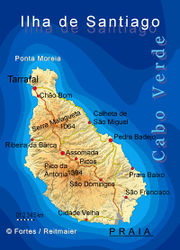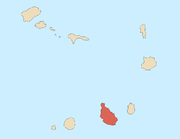Santiago, Cape Verde
| Native name: Santiagu | |
|---|---|
 |
|
 |
|
| Geography | |
| Location | Atlantic Ocean |
| Area | 991 km2 (382.6 sq mi) |
| Length | 75 km (46.6 mi) |
| Width | 35 km (21.7 mi) |
| Highest elevation | 1,394 m (4,573 ft) |
| Highest point | Pico da Antónia |
| Country | |
|
Cape Verde
|
|
| Concelhos (Municipalities) | Praia, Ribeira Grande de Santiago, Santa Catarina, Santa Cruz, São Domingos, São Lourenço dos Órgãos, São Miguel, São Salvador do Mundo, Tarrafal |
| Largest city | Praia (pop. 124,661) |
| Demographics | |
| Population | 240,000 |
| Density | 242.18 /km2 (627.24 /sq mi) |
Santiago (Portuguese for “Saint James”), or Santiagu in Cape Verdean Creole, is the largest island of Cape Verde, its most important agricultural centre and home to half the nation’s population. At the time of Darwin's voyage it was called St. Jago.
Santiago is located between the islands of Maio (40 km west) and Fogo (50 km east) and is one of the Sotavento. It was the first of the islands to be settled, the town of Cidade Velha being founded as Riberia Grande in 1462. It is also home to the nation's capital city of Praia and to one of the islands’ four international airports, Praia International Airport, 3 km from the capital (IATA airport code: RAI, Praia).
Contents |
Geography
Santiago is the largest island of Cape Verde, with an area of 991 km². The island is mountainous, although slightly flatter in the southeast. The wetter climate of the interior and the eastern coast contrasts with the dryer one in the south/southwest coast. Praia, located in the southeast coast, is the largest city of the island, and also the largest city and capital of the country. Other towns on the island include Cidade Velha, 15 km west of Praia, Cape Verde's first capital; Assomada, 60 km north and Tarrafal in the northern part of the island 75 km from the capital.
Settlements
- Achada
- Água do Gato
- Assomada
- Banana
- Boa Entrada
- Calheta de São Miguel
- Chão Bom
- Cidade Velha
- Curral de Baixo
- Fazenda
- Figueira da Naus
- João Vareia
- Mangue de Setes Ribeiras
- Pedra Badejo
- Picos
- Ponta Rincão
- Porto Formoso
- Porto Gouveia
- Porto Mosquito
- Praia
- Praia Baixo
- Principal
- Ribeira da Barca
- Ribeira da Prata
- Rui Vaz
- Santa Ana
- Santa Cruz
- São Domingos
- São Francisco
- São Jorge dos Órgãos
- Tarrafal
- Trás os Montes
History
The island was discovered by António da Noli in around 1460 who built a garrison in Cidade Velha which was then known as Ribeira Grande. Transcontinental slavery made Cidade Velha the second richest city in the Portuguese realm. Portugal was unable to protect its colonies because the English, Dutch, French and Spanish took over the slave trade and the island was later raided by pirates. In 1712, the capital no longer served Cidade Velha which was attacked by pirates and was moved to the Praia plateau. The island population were disadvantaged by the Portuguese colonial system and supported Amílcar Cabral and the African Party for the Independence of Guinea and Cape Verde and the independence of 1975. Santiago several times hosted conferences on Creole culture.
Population
Santiago has always been the most populous island in Cape Verde. The island population has doubled since the independence of Cape Verde in 1975. Other towns on the island include Assomada and Tarrafal.
Economy
The main industries are agriculture, tourism, fishing and others, and leastly manufacturing. Main agricultural products are corn, sugar cane, banana, coffee and mangoes.
Since the independence of Cape Verde, infrastructure has improved, especially schools, ports, airports, roads, etc.
Sporting teams
- Académica (Praia) - Praia
- AJAC
- Andorinha - São Domingos
- Bairro
- Boavista - Praia
- Celtic - Achadinha de Baixo
- Delta
- Desportivo - Assomada
- Desportivo - Praia
- Desportivo - Santa Cruz
- Estrela dos Amadores
- Flor Jovem
- Garridos
- Lapaloma
- Os Amigos - Assomada
- Praia Rural - Praia
- Sporting - Praia
- Tchadense - Praia
- CD Travadores - Praia
- Vitória FC
Persons
- Jorge Barbosa – writer;
- Arménio Vieira – writer;
- António Mascarenhas Monteiro – former President;
- José Maria Neves – present Prime Minister;
- Carlos Alberto Martins (Katchás) – musician;
- Orlando Monteiro Barreto (Orlando Pantera) – musician;
External links
- GTM - Santiago (Portuguese)
- http://www.genk.com/033 (Dutch)
- Street map: Street map from Mapquest, MapPoint or Google
- Satellite images: Google - image not yet available
- Coordinates:
|
|||||||||||||
Personalities: José Maria Neves, Prime Minister